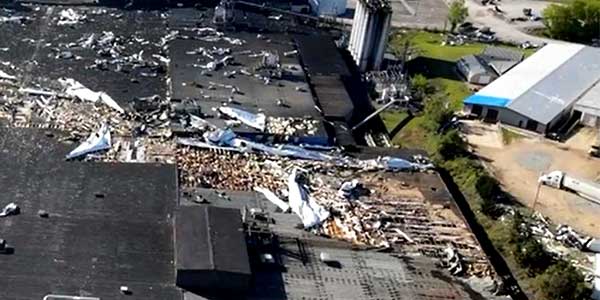Roof Emergency: Now What?

Wow, this summer's weather has not been easy for commercial facilities all over North America. Storms and tornadoes are putting roofs to the test, heat waves are skyrocketing cooling costs and Hurricane Beryl has left devastation in its path. According to forecasters, the remainder of this summer will also be challenging. Let’s make sure you are ready to weather the next storm.
A major storm hit your building. What to do?
Your course of action depends on the severity of the damage and the safety hazards it may pose. Here are some indicators that would warrant an emergency repair call:
1. Missing roof sections:
Your building's interior is now exposed to the elements.
2. Membrane blow-offs:
The waterproofing layer of your roof system is compromised, leaving the rest of the layers exposed to the elements.
3. Large holes in your roof:
Water may freely enter your building, saturating roof components and causing rot and decay not to mention disruption to business operations.
4. Active leaks:
Water dripping inside your building may cause interior damage, downtime and pose safety concerns.
5. Sagging roof:
This may indicate a serious safety hazard and a potential collapse ahead.
6. Water near electrical systems:
This may create a possibility of electrical fire or shock.
Need an emergency repair? Contact 855-483-1975 in the US and 800-690-6254 in Canada. Our team will swiftly assess your needs and complete any necessary repairs or temporary solutions to get your business watertight, allowing you to continue operations while working on permanent repairs or replacements.
Don’t overlook hidden damage.
We hope your facility made it through the recent storms without severe damage from high winds, flying debris or hail. However, it is essential to conduct a thorough post-storm roof evaluation since some damage may not be easily visible. For instance:
1. Membrane damage:
When your roof is hit by flying debris or hail, it can cause punctures and tears in the membrane. The stronger the wind, the greater the impact. This type of damage can lead to water intrusion, potentially resulting in significant damage over time.
2. Weakened roof system due to wind uplift:
High winds create a significant difference in air pressure between your roof's surface and the rest of the roof system, causing stress on various components over time. This stress can lead to issues such as membrane detachment, sealant and flashing failure as well as insulation movement. Read this article to learn more about wind uplift and its effects on commercial roofs.
3. Hidden leaks and moisture intrusion:
Even though they may not be immediately visible, lurking issues like hidden leaks and moisture intrusion can escalate into larger leaks, causing damage to your building or leading to mold and mildew issues.
4. Drainage system issues:
Debris landing on your roof can clog your drainage system, resulting in ponding water.
Addressing these potential issues through a comprehensive post-storm roof evaluation is important to prevent further damage to your facility. Conducting pre- and post-storm roof evaluations may drastically help you with the insurance claim process as well.
How to prepare for the next storm?
Here's a quick checklist to help you get your facility’s roof ready for the next storm or hurricane:
1. Conduct a roof evaluation:
Knowing your roof's condition will help you make the right decisions regarding roof repairs and maintenance.
2. Clean drains, gutters and downspouts:
Removing clogs in your drainage system will help prevent ponding water on your roof.
3. Secure your HVAC units and other rooftop equipment:
Any unsecured or loose objects on your roof may become a projectile in high wind. Ensure all rooftop items are locked in place and secure. Remove any loose items not essential to your operations during a high-wind event.
4. Trim vegetation:
Overhanging branches may cause damage during storms.
5. Secure roof access points:
Check the condition of your access ladders and hatches.
6. Check your roof warranty and insurance:
Hope for the best, prepare for the worst.
It's essential to regularly check your roof’s condition to maintain a watertight facility. We suggest conducting a roof evaluation every six months and after any significant weather event. Consider enrolling in a preventative maintenance program to ensure your roof is storm-ready in every season. Need help? Contact us today!
When you subscribe to the blog, we will send you an e-mail when there are new updates on the site so you wouldn't miss them.
We use cookies to improve your experience on our website. By clicking "I accept" or continuing to use our site, you consent to the use of cookies unless you have disabled them. Learn more here: Privacy Policy and CCPA.
